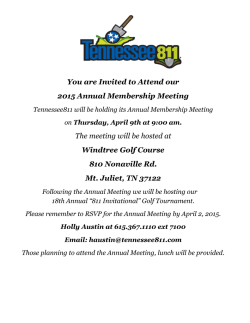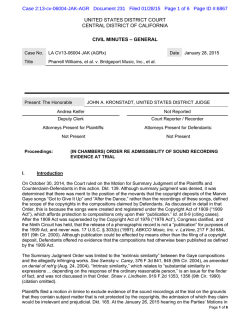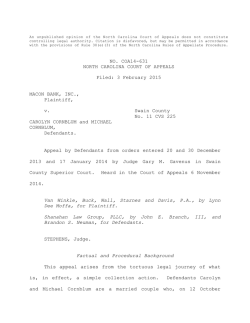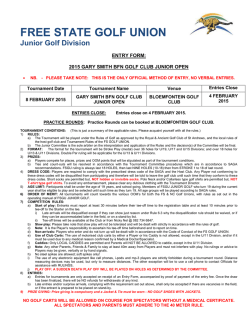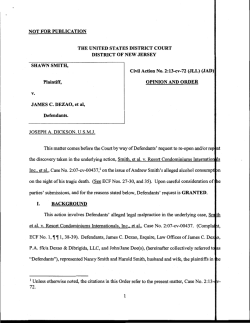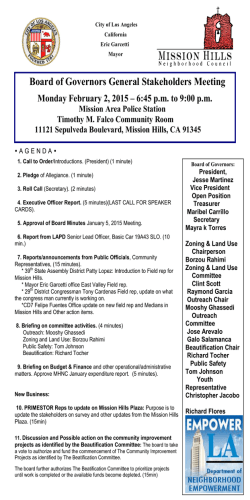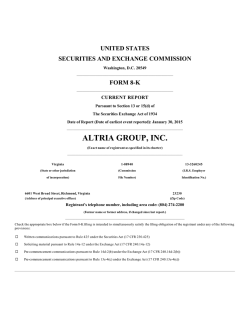
DA 14-0355 IN THE SUPREME COURT OF THE
February 3 2015 DA 14-0355 Case Number: DA 14-0355 IN THE SUPREME COURT OF THE STATE OF MONTANA 2015 MT 30 WENDELL E. BENNETT JR. and KATHRYNE L. BENNETT, KARLA LANGE, SCHNEITER ENTERPRISES, LTD, ROGER F. DALLNER TRUST, Plaintiffs and Appellants, ANNETTE L. EFTA and AARON J. EFTA, PAUL T. CORCORAN, Plaintiffs, v. RONALD S. HILL, individually, SPECIALIZED CONSTRUCTION, INC., RONALD S. HILL, LLC, LAKE HILLS GOLF, LLC., Defendants and Appellees. APPEAL FROM: District Court of the Thirteenth Judicial District, In and For the County of Yellowstone, Cause No. DV 13-213 Honorable Ingrid Gustafson, Presiding Judge COUNSEL OF RECORD: For Appellant: Kenneth D. Peterson, Attorney at Law; Billings, Montana For Appellee: David J. Dietrich, Jacob A. Yerger, Dietrich & Associates, P.C.; Billings, Montana Filed: Submitted on Briefs: December 17, 2014 Decided: February 3, 2015 __________________________________________ Clerk Justice Michael E Wheat delivered the Opinion of the Court. ¶1 Wendell Bennett, Jr., Kathryne Bennett, Karla Lange, Schneiter Enterprises, LTD, and Roger F. Dallner Trust (“Appellants”) appeal from the orders of the Montana Thirteenth Judicial District Court, Yellowstone County, granting summary judgment and ordering attorney fees in favor of Ronald Hill, Specialized Construction, Inc., Ronald S. Hill, LLC, and Lake Hills Golf, LLC (“Defendants”). We reverse and remand. ISSUES ¶2 We review the following issues: 1. Did the District Court err by granting summary judgment in favor of the Defendants on the issue of whether the wall constituted a spite fence? 2. Did the District Court err by granting summary judgment in favor of the Defendants on the issue of whether the wall constituted a nuisance? 3. Did construction of the wall violate the Subdivision Restrictions? 4. Did the District Court err by awarding attorney fees to the Defendants? FACTUAL AND PROCEDURAL BACKGROUND ¶3 Annette and Aaron Efta, Paul Corcoran, and the Appellants (collectively “the Plaintiffs”) own Lots 4, 5A, 6A, 7, 8, 9, and 10 of the 17th Filing for Lake Hills Subdivision. Lake Hills Golf, LLC owns Lot 5 in Tract B1 (hereinafter “Golf Course Property”), which is also in the Lake Hills Subdivision and is adjacent to the Plaintiffs’ 2 properties. The present case concerns a wall1 that the Defendants constructed near the border shared by the Golf Course Property and the Plaintiffs’ properties. ¶4 In 1958, the owners of the Lake Hills Subdivision recorded a document entitled “Declaration of Restrictions” (hereinafter “Restrictions”) with Yellowstone County. The document set forth a number of restrictive covenants, limiting the use and development of the properties in the Lake Hills Subdivision. Relevant to this case, it stated that: 1. None of the lots or tracts in any of the zones hereinafter described shall be used except for a use or purpose herein specifically permitted, and no structure shall hereafter be erected on any lot or tract nor any structure maintained on any lot or tract except the structure herein specifically permitted. . . . 3. . . . No building hereafter to be erected on any lot or tract shall be commenced until written authority for the construction of such building has been secured from the Architectural Control Committee hereafter provided for. . . . 6. No fence or wall shall be erected or maintained on any lot, nor any hedge planted or maintained on any lot until written authority therefor has been secured from the Architectural Control Committee which shall have authority to prescribe the location, height, design and materials used. . . . 16. If used as a public or private golf course, country club, or park, any structure incidental to such use, including but not limited to clubhouse, swimming pool, tennis courts and other recreational facilities, storage shops, While the Appellants describe the structure at issue in this case as a “wall,” the Defendants have indicated several times that they believe that the structure should be called a “fence.” Neither party, however, has indicated that this is an important distinction to consider on appeal. Without deciding whether the distinction between a wall and a fence has a bearing on the issues in this case or whether one description is more apt, we have decided to refer to the structure at issue in this Opinion as a “wall.” 3 1 and repair and maintenance facilities and shops, may be maintained and erected on any of the said tracts. The Restrictions also stated that they were to run with the land and be binding against the present and all subsequent owners of tracts and lots in the Lake Hills Subdivision. The document gave any owner of any lot or tract the ability to enforce the Restrictions. Several amendments have been made to the Restrictions, but no amendment that has been made part of the record on appeal has affected the language quoted above in any way relevant to this Opinion. ¶5 At times following recordation of the Restrictions, the Plaintiffs and Lake Hills Golf, LLC purchased their Lake Hills Subdivision properties. Hill, acting on behalf of Ronald S. Hill, LLC (which has since changed its name to Lake Hills Golf, LLC), obtained the Golf Course Property via a warranty deed dated November 25, 2009. The deed specifically conveyed the Golf Course Property subject to, among other things, the Restrictions and its amendments. ¶6 On March 7, 2011, Hill applied for a zoning change to a number of the other lots he owned in the Lake Hills Subdivision. The Plaintiffs opposed the zoning change, and they claim that this opposition soured their relationships with Hill. Hill ultimately withdrew his application. ¶7 On October 16, 2012, Hill applied for a building permit from the City of Billings. He sought permission to build the structure that is now the wall at issue here. The permit was granted and Hill subsequently contracted with Specialized Construction, Inc. to build the wall. The wall, constructed at a cost of $40,000, is made of concrete and rebar. It extends to 4 a height of approximately 9 feet above the ground. Set approximately 10 feet from the border between the Golf Course Property and the Plaintiffs’ lots, the wall runs approximately parallel to and for the length of that border. At 40-foot intervals along its approximately 800-foot length, the wall jogs 2 feet in a direction perpendicular to its length. ¶8 Following completion of the wall, the Plaintiffs sued the Defendants, claiming, in relevant part, that the wall was constructed in violation of the Restrictions, that the wall constituted a nuisance, and that the wall constituted a spite fence. Following discovery, the Defendants moved for summary judgment on each of these issues. Plaintiffs opposed this motion and asked for partial summary judgment on the issue of whether the wall violated the Restrictions. Resolving these competing motions, the District Court granted summary judgment on all of the issues in favor of the Defendants. It also awarded the Defendants attorney fees. The Appellants appeal. STANDARDS OF REVIEW ¶9 We review a district court’s summary judgment ruling de novo, applying the same rule, M. R. Civ. P. 56(c)(3), that a district court does when making a summary judgment ruling. Beaverhead Cnty. v. Mont. Ass’n of Cntys. Joint Powers Ins. Auth., 2014 MT 267, ¶ 11, 376 Mont. 413, 335 P.3d 721. Summary judgment “should be rendered if the pleadings, the discovery and disclosure materials on file, and any affidavits show that there is no genuine issue as to any material fact and that the movant is entitled to judgment as a matter of law.” M. R. Civ. P. 56(c)(3). ¶10 Whether there is legal authority for an award of attorney fees is a conclusion of law. Lewis & Clark Cnty. v. Hampton, 2014 MT 207, ¶ 23, 376 Mont. 137, 333 P.3d 205. A 5 district court’s interpretation of a restrictive covenant is also a conclusion of law. Creveling v. Ingold, 2006 MT 57, ¶ 5, 331 Mont. 322, 132 P.3d 531. We review a district court’s conclusions of law for correctness. Lewis & Clark Cnty., ¶ 23; Creveling, ¶ 5. DISCUSSION ¶11 1. Did the District Court err by granting summary judgment in favor of the Defendants on the issue of whether the wall constituted a spite fence? ¶12 The District Court granted summary judgment on the claim that the wall was a spite fence. It determined that recovery on a spite fence claim is only allowed where the defendant receives no benefit from the wall or fence. Deciding that there was no genuine issue that the wall in this case prevented trash and trespassers from entering the golf course’s 10th fairway and deciding that this was a beneficial, non-spite use, the District Court granted summary judgment and dismissed the spite fence claim. ¶13 The Appellants argue that this ruling was in error. They claim that there is a genuine issue concerning whether the wall serves any beneficial purpose, and that for this reason, summary judgment should have been denied. We agree. ¶14 When considering a motion for summary judgment and whether there is a genuine issue of material fact, a district court must consider the evidence in the light most favorable to the non-movant, drawing all reasonable inferences in the non-movant’s favor. Thornton v. Flathead Cnty., 2009 MT 367, ¶ 13, 353 Mont. 252, 220 P.3d 395. Here, the District Court did not do so. It considered the affidavits and testimony of the Defendants and then dismissed much of the Plaintiffs’ evidence as either inconsequential or “highly unlikely” to support the conclusions the Plaintiffs proposed. 6 ¶15 In particular, the District Court determined that the wall served a useful, non-spite purpose to the Defendants by preventing trash and trespassers from entering the Golf Course Property. Affidavits from the Plaintiffs, however, included statements that they had never received complaints about trash or seen trash enter the Golf Course Property from their properties. They also stated that they had never observed trespassers cross the Golf Course Property from their properties. One of the Plaintiffs also stated that Hill had told him that the wall was built because the Plaintiffs’ properties were unattractive. ¶16 The District Court concluded that this evidence did not controvert the evidence provided by the Defendants, reasoning that just because the Plaintiffs did not see any trash does not mean that there was no trash. This reasoning does not afford the Plaintiffs’ evidence the favorable inferences summary judgment consideration demands. See Thornton, ¶ 13. Instead, a reasonable inference, viewing the statements in the Plaintiffs’ affidavits in the light most favorable to their position, is that since the landowners never saw trash blow from their property onto the Golf Course Property and never received complaints about such trash, no such trash existed. A similar inference can be made regarding the existence of trespassers, based on the Plaintiffs’ evidence. ¶17 For this reason, there was a genuine issue as to whether there were any trespassers or trash to stop, and, accordingly, as to whether the fence served the beneficial purpose of stopping such trash and trespassers. The District Court erred by finding otherwise, and we reverse its order granting summary judgment on the spite fence claim in favor of the Defendants. 7 ¶18 2. Did the District Court err by granting summary judgment in favor of the Defendants on the issue of whether the wall constituted a nuisance? ¶19 The District Court applied its reasoning on the spite fence issue to resolve the nuisance claim. It reasoned that since there was no genuine issue that the wall served a “reasonable purpose” in stopping trash and trespassers, the Defendants were entitled to summary judgment on the nuisance claim. ¶20 Yet, this reasoning is based on an erroneous interpretation of the law. A beneficial or reasonable purpose will not immunize something that would otherwise constitute a nuisance from being ruled a nuisance. Montana statute states that “[a]nything that is injurious to health, indecent or offensive to the senses, or an obstruction to the free use of property, so as to interfere with the comfortable enjoyment of life or property . . . is a nuisance.” Section 27-30-101(1), MCA (emphasis added). Although there are exceptions for farming operations, activities authorized by statute, and noises from shooting activities at shooting ranges, Montana statute does not otherwise limit this broad definition of what may or may not constitute a nuisance. See Title 27, chapter 30, MCA; Tarlton v. Kaufman, 2008 MT 462, ¶ 24, 348 Mont. 178, 199 P.3d 263; see also Martin v. Artis, 2012 MT 249, ¶ 14, 366 Mont. 513, 290 P.3d 687 (“[W]hile it is possible . . . for ‘anything’ to constitute a nuisance, a nuisance claim must nonetheless plead a factual foundation that satisfies governing legal standards.”). As in Tarlton, where we were, absent statutory authority, unwilling to read a limitation into the nuisance statute that would prevent aesthetic considerations from constituting nuisance, we are similarly unwilling to rule that anything that has a beneficial or reasonable use cannot also be a nuisance. Tarlton, ¶ 24. 8 ¶21 Indeed, such a ruling would be at odds with our precedent. We have upheld, for example, District Court rulings finding the operations of a plywood manufacturing plant, a fence, and a “bothersome” mule to be nuisances. While there are beneficial uses to defendants from such activities and structures, such beneficial or reasonable uses have not prevented this Court or lower courts from finding that the activities and structures were nuisances. See Stamm v. Kehrer, 222 Mont. 167, 168, 171, 720 P.2d 1194, 1195-96 (1986); Ekwortzel v. Parker, 156 Mont. 477, 478-79, 482, 482 P.2d 559, 561-62 (1971); Nelson v. C & C Plywood Corp., 154 Mont. 414, 416-17, 434, 465 P.2d 314, 315, 325 (1970); see also W. Page Keeton et al., Prosser and Keeton on Torts §§ 87, 88, at 623, 629 (5th ed. 1984) (explaining that conduct that is socially desirable may still constitute a nuisance). ¶22 Furthermore, even if the District Court did not err in its interpretation of the law, there is, as discussed above with regard to Issue 1, a genuine issue concerning whether the wall served a “reasonable purpose” by stopping trash and trespassers. For these reasons, we reverse the District Court’s order granting summary judgment on the issue of nuisance. ¶23 3. Did construction of the wall violate the Subdivision Restrictions? ¶24 The Appellants contend that the wall was constructed in violation of Paragraph 6 of the Restrictions. Although the Defendants admit that the Restrictions apply to the Golf Course Property, as covenants that run with the land, they argue that the provisions of Paragraph 6 have been waived and are unenforceable against them. They also argue in the alternative that Paragraph 16 provides an exception to Paragraph 6 that permitted them to construct the wall without approval from the Architectural Control Committee (ACC). Yet, 9 there are genuine issues of material fact such that summary judgment was not appropriate based on either ground that the Defendants raise. ¶25 Waiver of a covenant may operate to render the covenant unenforceable by the party waiving it. To establish waiver, the party asserting waiver must demonstrate that the other party knew of and acted inconsistently with a covenant, and that prejudice resulted to the party asserting waiver. McKay v. Wilderness Dev., LLC, 2009 MT 410, ¶ 28, 353 Mont. 471, 221 P.3d 1184. Waiver may be either express or demonstrated by a course of conduct. If waiver is demonstrated by a course of conduct, whether waiver occurs and which covenants are affected by the waiver will depend “upon the circumstances of each case and the character and materiality of the permitted breach.” See Kelly v. Lovejoy, 172 Mont. 516, 520, 565 P.2d 321, 324 (1977). ¶26 Here, the facts alleged do not support waiver of the covenants in Paragraph 6, even if we take the facts upon which the District Court relies and the facts the Defendants alleged to be true. Doing so, we assume arguendo that the ACC has never met and has never approved a construction project of any kind. We also assume arguendo, as the District Court decided, that “the vast majority of the residences and structures within the Lake Hills Subdivision were built without written approval from the ACC.” ¶27 Such facts do not establish the existence of breaches of the “character and materiality” that would demonstrate waiver of Paragraph 6. Paragraph 6 specifically prohibits the construction of any fence, wall, or hedge without the written approval of the ACC. This prohibition is distinct from Paragraph 3’s general prohibition on building without ACC approval. Although there is evidence that general building has occurred without ACC 10 approval, such evidence does not indicate that breaches occurred of the character and materiality sufficient to waive the specific prohibitions of Paragraph 6. Importantly, the facts relied upon by the Defendants and the District Court do not indicate that any fence, wall, or hedge has ever been constructed by any Lake Hills Subdivision resident in violation of Paragraph 6. Indeed, there is no evidence that any fences, walls, or hedges even exist in Lake Hills Subdivision. As such, we cannot conclude as a matter of summary judgment that any rights in Paragraph 6 were knowingly relinquished by any party. Because there is no evidence that any action inconsistent with Paragraph 6 has occurred, let alone one of the character and materiality of the alleged breach here, the District Court erred by granting summary judgment and deciding that Paragraph 6 has been waived. ¶28 Moreover, that the ACC has never met is also not enough to establish waiver. At most, this might indicate that the exception to Paragraph 6’s general prohibition has never been exercised and is no longer available. It does not follow that the general rule was knowingly relinquished, based on knowing relinquishment of the exception to that rule. It is our goal in interpreting, construing, and applying covenants to give effect to the intentions of the parties where possible. See § 28-3-301, MCA; Creveling, ¶ 8. And, such a finding would spoil the intention of the parties to the Restrictions, which, as expressed by the plain language of the Restrictions, was to prohibit fences, walls, and hedges except in limited, approved circumstances. For these reasons, the District Court erred by granting summary judgment based on its conclusion that the covenants in Paragraph 6 of the Restriction had been waived. 11 ¶29 Construction of the wall also was not, despite the Defendants’ contentions otherwise, allowed by Paragraph 16 of the Restrictions. While we agree with the District Court that Paragraph 16 provides an exception to the restrictions of Paragraph 6 for structures incidental to a property’s use as a golf course, we do not agree that there is no genuine issue that the wall is “incidental” to use of the Golf Course Property as a golf course. The District Court, in coming to the opposite decision, seems to again have relied upon the reasoning and analysis it applied to the spite fence issue, concluding that since the purpose of the wall is to stop trash and trespassers, the wall is incidental to the use of the property as a golf course. Yet, even if we were to assume, as the parties seem to do, that such a purpose would necessarily render the wall “incidental” to the property’s use as a golf course, we do not agree that there is no genuine issue that the wall is used to stop trash and trespassers, as discussed above. ¶30 For this reason, we do not agree that there is no genuine issue that the wall is incidental to use of the Golf Course Property as a golf course, and we reverse the District Court’s order granting summary judgment on the issue of whether the wall violates the Restrictions. ¶31 4. Did the District Court err by awarding attorney fees to the Defendants? ¶32 The Appellants argue that the District Court should not have awarded attorney fees in favor of the Defendants. Due to our decision to reverse summary judgment on the foregoing issues, the Defendants have not prevailed in this matter. Accordingly, the order awarding attorney fees must be reversed, and we need not reach the merits of the parties’ arguments 12 concerning whether the Defendants were entitled to receive those fees under the Restrictions and Montana Statute. Harland v. Anderson Ranch Co., 2004 MT 132, ¶ 44, 321 Mont. 338, 92 P.3d 1160. CONCLUSION ¶33 For each of the issues discussed above, we hold either that the District Court’s application of the law was incorrect or that there were genuine issues of material fact. For this reason, we reverse the District Court’s order granting summary judgment in favor of the Defendants, and we remand for proceedings consistent with this Opinion. As such, we also reverse the order granting attorney fees. Reversed and remanded. /S/ MICHAEL E WHEAT We Concur: /S/ MIKE McGRATH /S/ LAURIE McKINNON /S/ BETH BAKER /S/ JAMES JEREMIAH SHEA 13
© Copyright 2024
